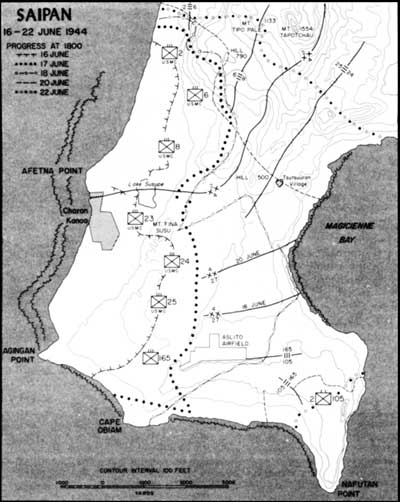| Marines in World War II Commemorative Series |
|
BREACHING THE MARIANAS: The Battle for Saipan by Captain John C. Chapin U.S. Marine Corps Reserve (Ret) D+4-D+7, 19-22 June The most critical event of 19 June (and perhaps the most important of the whole Saipan campaign) took place at sea, well out of sight of the infantrymen ashore. The opposing carrier task forces clashed in a gigantic air battle. When it was over that night, the Japanese had suffered the catastrophic loss of 330 out of 430 planes they had launched. Exultant U.S. Navy fliers labelled it "The Great Marianas Turkey Shoot." With the help of American submarines and additional carrier plane attacks the next day, the Japanese attempt to relieve Saipan by a decisive naval victory was smashed. As an official account summarized the impact ashore, "the eventual doom of the enemy garrison was assured." And the American supply ships were able to return offshore to unload their vital cargoes. During the four-day span of D+4 to D+7, the 105th Infantry moved slowly along the south coast and then joined the 165th Infantry in sealing off the die-hard Japanese survivors in Nafutan Point, in the southeastern corner of the island. Once the enemy was penned in, the 105th was assigned to eliminate him. The rest of the 27th Division, now including the 106th Infantry, was ordered north to be the Corps reserve.
This period, 19-22 June, marked a total shift in direction for the American troops. Pivoting on the 2d Marines on the far left flank along the western shore, the other Marine regiments swung around from their drive which had reached the east coast to face north, with their right flank on Magicienne Bay On 20 June, the 4th Division confronted a key objective. Lieutenant Chapin had a ringside seat:
Over in the area of the 2d Division, the 8th Marines wheeled from facing east to attack northward into the foot hills leading to Mount Tapotchau. The Marine divisions were now facing two major problems. First, their drive north was confronted by General Saito's main line of defense, running west to east across the island. Secondly, the terrain into which the attack had to go was a nightmare of ravines, caves, hills, valleys, and cliffs—all fortified and defended to the death by the Japanese. June 21 brought a respite for the front line troops: "D+6 was enjoyed by all—for a change! We rested on our positions; caught up on sorely needed sleep; got some water (which had been conspicuous by its absence); and even had a good hot meal. For we got our first 10-in-1 rations. Did they ever taste good to our hungry palates, surfeited as they were with K rations!" Simultaneously, intensive preparations were made for a coordinated attack by both Marine divisions the next morning. A total of 18 artillery battalions were massed for supporting fire. Combat efficiency was officially rated as "very satisfactory," in spite of a sobering total of 6,165 casualties. The following day saw the Marines attack all along the line. The 6th Marines overran parts of Mount Tipo Pali, while the 8th Marines worked its painful way into the maze of ridges and gullies that formed the foothills of Mount Tapotchau. On the right, the 24th Marines was forced into the messy business of blasting caves honey combed along Magicienne Bay. In one of the mortar platoons, a weird encounter took place, as de scribed at the time to this author by the participant, First Lieutenant Joseph J. Cushing:
On the left of the 4th Division, the 25th Marines made a major advance of 2,400 yards. The forward lines were now reaching an area where the Kagman Peninsula jutted out to the east. This resulted in a substantially increased frontage that the two Marine divisions could not properly cover. To deal with this, Holland Smith decided to commit his reserve, the 27th Infantry Division, to the center of the line, leaving just one battalion of the 105th Infantry way back in the rear to continue its long drawn-out attempt to eliminate the Japanese pocket on by-passed Nafutan Point.
This day (D+7) was also marked by the arrival of P-47 Thunderbolts of the 19th Fighter Squadron, U.S. Army Air Forces, which landed at Aslito Field. They had been launched from Navy escort carriers. When landed, they were fitted with launching racks for rockets by ground crews who had come in earlier. Later that day, eight planes took off on their first support mission of the Saipan campaign. (Only two Marine observation squadrons, VMO-2 and VMO-4, were involved in the battle for Saipan, but they provided invaluable artillery spotting for the two Marine divisions.) While these developments were taking place in the upper echelons, down in the rock-bottom basic life of infantry platoons, the days of relentless combat pressure were exemplified by their impact on the constant duties and high stress levels on a platoon commander:
|





